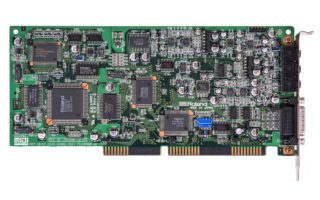Roland RAP-10 is not as known as LAPC-I or SCC-1, but it sure is more interesting, in my opinion. RAP stands for Roland Audio Production and as the name suggests, it was made for audio production. Although, it was an excellent card for audio production, I am, as always, interested in DOS games. Is this card really that good? Can it even be used in DOS games? Let’s dive into the world of Roland’s perfection and let’s hear if Roland deserves the praise it usually gets.
RAP-10 is essentially Sound Canvas SC-7 with MPU-401 interface and 16bit digital audio, so it should be possible to use it in any game that supports General MIDI. We’ll see about that. SC-7 was a younger brother to SC-55. SC-7 should be on par with SC-55. They should have identical instrument sets, SC-7 as well as RAP-10 is GM only, it doesn’t support Roland’s own GS standard, which is a bit weird on a production card. But since we are here for DOS gaming, it should be perfect for playing back MIDI music in games.
Roland released cards like LAPC-I or SCC-1, these cards can handle only MIDI playback, RAP on the other hand, is the first and also the last Roland’s card, that supports digital audio and Roland’s last PC based ISA card. Card’s resolution is 16bit at 44kHz, so it should be crystal clear. Unfortunately, there is no Sound Blaster emulation for this card, so I assume games need direct RAP support, otherwise sounds won’t work. It doesn’t even have OPL chip or any kind OPL clone chip, so if you like FM synth, this card is not for you. Games supporting only Sound Blasters or sound cards with OPL chip shouldn’t work at all with RAP.
Let’s set up the card. There are couple of jumpers and switches you need to set up. First switch enables or disables joystick, the rest is to select the address. Default address is of course 330 so I’m gonna leave it there. Jumpers right under the switches set IRQ, the default is 9, I’m gonna leave it there as well. Another jumper sets the mic and line in to stereo or mono and the last jumper just turns off the sound output.
Back panel holds the usual mic/line in, auxiliary in and speaker out. Joystick and MIDI connector is as usually on the left side of the card. Even though the card’s got an amplified output, it’s super clean, as you’d expect from a production card. To connect an external MIDI device, you need Roland’s breakout box. I wouldn’t use any other external General MIDI device for DOS gaming, RAP should be perfect. The only device that I would use, would be MT-32.
There are no drivers nor any other utilities for DOS, which means no mixer and no Sound Blaster emulation. I found a list of games with direct RAP-10 support, I’ll try as many as I can to find out how many of those actually work.
First game I tried was Abuse. Weird thing about Abuse is, it supports all sorts of Roland devices for music including RAP-10, but not for sound effects. I don’t understand why they bothered to include the music driver, but not the sound driver.
Second game was Albion. It uses Miles Drivers and as I said many times before, Miles drivers are pretty much dumb proof and work every time. The setup of course supports RAP-10 for sound and General MIDI for music. So, any game that uses Miles drivers should work with this card perfectly.
If a game supports General MIDI, MPU-401, Sound Canvas or SCC-1, it works perfectly and sounds sick. It is also possible to use drivers for MT-32 or LAPC-I, it is somewhat compatible. But it’s far cry from perfect. RAP-10 is General MIDI only card and uses only necessary number of instruments to comply with General MIDI standard, which is 128 instruments and thus uses these instruments to somehow emulate MT-32.
All games with RAP sound support worked perfectly except one, Tomb Raider. Setup detected the card, it even made a sound, but it was anything but pleasant. I tried different settings, different hardware, different DOS versions, nothing helped. The rest of the games worked fine though.
So, if you’re after an internal sound card that handles General MIDI in exceptional quality, sounds cracking, and works in every game that supports General MIDI or any kind of Roland, go for it, you won’t be disappointed. It can also handle digital audio in 16bit at 44kHz and the output is super clean. Unfortunately, to get all games working, you still need another sound card, because RAP is not widely supported as a sound effects card. The card, however, is quite rare and can be bloody expensive. There are not many sound cards, out there, that sound this good. I said that it should sound pretty much the same as SC-55, most of the time it’s true, however, during the test, I noticed slight differences. Some of the instruments sounded a bit different, not worse, but different. Overall, all instruments sounded more pronounced, more noticeable and stand out in the song. So, in the end, I like this much more than SC-55 or any other sound card yet. The only drawback is the digital audio support, but this card is so good and kind of special, that I can live with that. I still need to get my hands on SCC-1 and LAPC-I, but this card is a treat.

